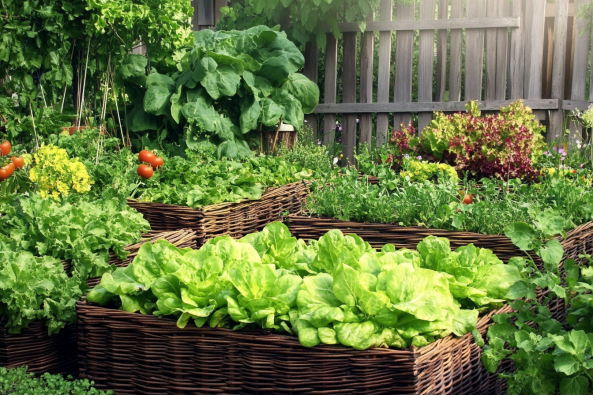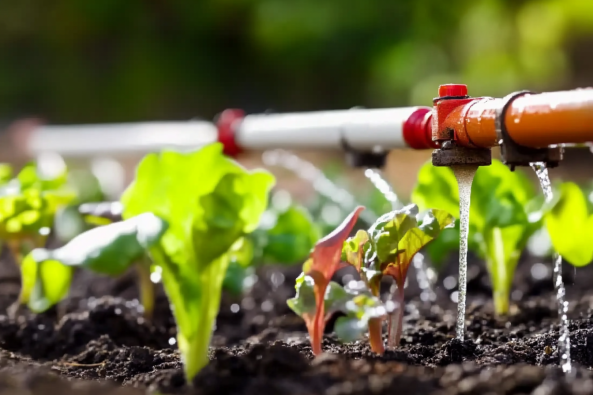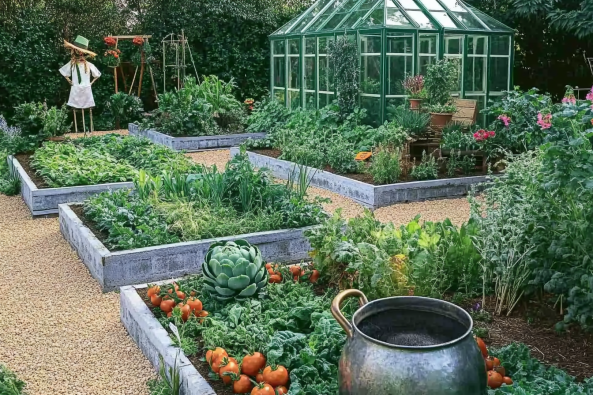Gardening with vegetables is a rewarding way to grow fresh, organic food while saving money. Whether you’re working with a large backyard or a small balcony, these 10 easy DIY vegetable gardening ideas will help you create a thriving home garden.
1. Build Raised Garden Beds for Better Growth
Raised beds offer better drainage, prevent soil compaction, and make it easier to manage weeds.
- Benefits of raised beds for vegetable gardening:
- Improves soil quality and root development
- Helps extend the growing season
- Prevents pests like slugs and snails
- Step-by-step guide to constructing a simple raised bed:
- Choose a sunny location.
- Use untreated wood, bricks, or metal frames to build the borders.
- Fill with nutrient-rich soil and compost.
- Plant vegetables like tomatoes, carrots, or lettuce.
Related Post:
Top Landscaping Trends to Watch in 2025
2. Try Companion Planting for Healthier Crops

Pairing compatible vegetables together can boost yields and reduce pests.
- Best vegetable pairings to boost yield:
- Tomatoes and basil (enhances growth and flavor)
- Carrots and onions (repels pests)
- Beans and corn (natural nitrogen boost)
- Natural pest control and soil improvement techniques:
- Use marigolds to repel insects
- Rotate crops each season to maintain soil health
3. Create a Vertical Vegetable Garden to Maximize Space
If space is limited, a vertical garden is a great way to grow more vegetables in a small area.
- Ideas for trellises, stacked planters, and hanging baskets:
- Use a wooden trellis for climbing plants like peas and beans
- Stack old crates for a multi-layered planter
- Install wall-mounted hanging baskets for herbs and lettuce
- Best vegetables for vertical gardening:
- Cucumbers, cherry tomatoes, pole beans, and strawberries
4. Repurpose Household Items for Unique Planters
Give old items a new life by creating a DIY container garden.
- DIY container garden using crates, barrels, and old tires:
- Use wooden crates for herbs and small vegetables
- Convert an old tire into a raised planter
- Repurpose barrels for deep-rooted plants like potatoes
- Best vegetables for container gardening:
- Peppers, spinach, radishes, and lettuce
External Resource:
DIY Gardening Ideas with Vegetables
5. Make a Simple Hydroponic System at Home
Hydroponic gardening is a soil-free way to grow vegetables indoors or outdoors.
- Easy, low-cost setup for growing vegetables without soil:
- Use PVC pipes or plastic containers for water circulation
- Provide liquid nutrients for plant growth
- Keep roots submerged in the nutrient-rich solution
- Best veggies to grow hydroponically:
- Lettuce, spinach, cherry tomatoes, and bell peppers
6. Design a Tiered Vegetable Garden for a Stylish Look
A tiered garden maximizes space while creating a visually appealing arrangement.
- How to layer plants for aesthetic appeal and efficiency:
- Place taller plants like corn at the back
- Medium-height vegetables like peppers in the middle
- Low-growing plants like lettuce at the front
- DIY tutorial for a tiered planter box:
- Use wooden planks to create step-like sections
- Secure each level for stability
- Fill with soil and plant desired vegetables
7. Start a Hanging Gutter Garden for Leafy Greens
A gutter garden is a space-saving solution for growing greens on walls or fences.
- Step-by-step guide to installing a gutter garden:
- Secure old gutters onto a wooden frame or fence
- Drill drainage holes at the bottom
- Fill with soil and plant leafy greens
- Best vegetables to grow in a hanging system:
- Spinach, kale, arugula, and lettuce
8. Create a Mini Greenhouse for Year-Round Vegetables
A mini greenhouse helps extend the growing season, keeping vegetables thriving in colder months.
- Using PVC pipes, plastic sheets, or old windows:
- Build a simple frame using PVC or repurpose old windows
- Cover with clear plastic to trap heat
- Ventilate to prevent overheating
- Best vegetables for greenhouse gardening:
- Tomatoes, peppers, lettuce, and cucumbers
9. DIY Compost Bin to Boost Soil Health
Composting is an eco-friendly way to turn kitchen scraps into nutrient-rich soil.
- Simple methods for creating nutrient-rich compost:
- Use a wooden bin, plastic container, or compost tumbler
- Add a mix of green (fruit peels, grass) and brown (dry leaves, paper) materials
- Turn regularly to speed up decomposition
- Best composting practices for vegetable gardens:
- Avoid meat and dairy waste
- Keep compost moist but not soggy
10. Install a Drip Irrigation System for Water Efficiency

Drip irrigation helps conserve water while keeping plants hydrated.
- Easy DIY irrigation setup:
- Use PVC pipes or hoses with small holes
- Connect to a water source and regulate flow
- Direct water to plant roots to prevent evaporation
- How to keep your vegetable garden hydrated with minimal effort:
- Water in the early morning or evening
- Mulch around plants to retain moisture
Related Post:
Top Landscaping Trends to Watch in 2025
Choosing the Right Vegetables for Your DIY Garden
- Easy-to-grow options for beginners:
- Tomatoes, zucchini, radishes, and beans
- Leafy greens like spinach and lettuce
Maintenance Tips for a Thriving Vegetable Garden
- Watering, fertilizing, and pest control strategies:
- Use organic fertilizer for strong growth
- Introduce beneficial insects like ladybugs to combat pests
Frequently Asked Questions About DIY Vegetable Gardening
Q: How much sunlight do vegetable gardens need?
A: Most vegetables require 6-8 hours of direct sunlight daily.
Q: What are the easiest vegetables to grow in containers?
A: Lettuce, radishes, cherry tomatoes, and herbs like basil and parsley.
Q: How can I prevent pests in my vegetable garden?
A: Use companion planting, neem oil spray, and floating row covers.
External Resource:
DIY Gardening Ideas with Vegetables
With these 10 easy DIY gardening ideas, you can create a thriving vegetable garden that’s productive and sustainable. Whether you’re working with limited space or experimenting with new techniques, these projects will help you grow fresh, organic vegetables at home!

